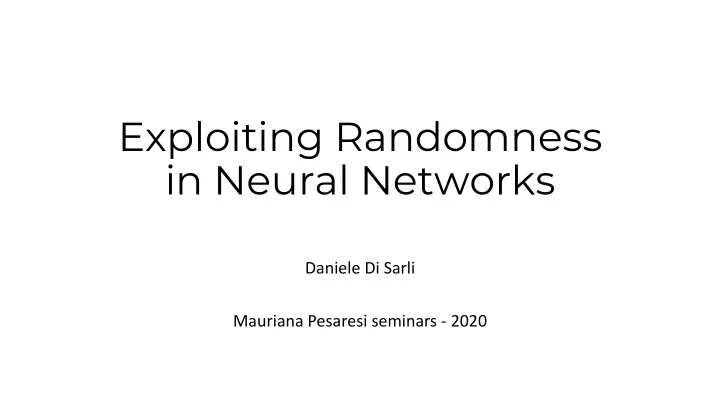

Exploiting Randomness in Neural Networks Daniele Di Sarli Mauriana Pesaresi seminars - 2020
Recurrent Neural Network
error = (output – expected) 2 ∂error ∂ W Backpropagation Through Time
PREDICTION PATTERNS, INTERACTIONS …, 3, 2, 1.5, 0.75, 1, -2.3, 4, …
Reservoir Readout
Reservoir Readout
Reservoir Readout Echo State Network
(a) (b) (c) (d)
Cover’s theorem
Echo State Property
Echo State Network starter pack 1. Randomly initialize the weights (sparse) 2. Rescale the weights to guarantee contractivity of the state transition function (=> ESP) 3. Feed data, collect states 4. Compute optimal linear regression parameters
« RC […] provides explanations of why biological brains can carry out accurate computations with an “inaccurate” and noisy physical substrate » — Lukoševičius et al. In the primary visual cortex , «computations are performed by complex dynamical systems while information about results of these computations is read out by simple linear classifiers .» — Nikolić et al.
My work
Natural Language Processing LSTM GRU Transformer BERT CO 2 emissions (lbs) Car, avg incl. fuel, 1 lifetime Transformer w/ neural arch. search 0 100000 200000 300000 400000 500000 600000 700000 From Strubell, E., Ganesh, A., McCallum, A. : Energy and Policy Considerations for Deep Learning in NLP Proceedings of the 57th Conference of the Association for Computational Linguistics, 2019
Text Classification pipeline -0.76, 0.35, … -0.02 RNN ‘My input sentence’ input sequence sentence embedding linear classifier (word embeddings) TRAINING
Text Classification pipeline -0.76, 0.35, … -0.02 ESN ‘My input sentence’ input sequence sentence embedding linear classifier (word embeddings) TRAINING
Question Classification What was the name of the first Russian astronaut to do a spacewalk? HUMAN What's the tallest building in New York City? LOCATION … also ABBREVIATION, ENTITY, DESCRIPTION, and NUMERIC VALUE
Improvements are needed • Bidirectional What's the tallest building in New York City? • Attention • Multi-ring
Improvements are needed • Bidirectional What's the tallest building in New York City? • Attention • Multi-ring
Improvements are needed • Bidirectional • Attention • Multi-ring
Results Accuracy 100 200M+ params, ours 98 heavy transfer learning < 1.6M params 96 94 92 90 88 N M r N U N ) t e o t S A N N R l T t E b G C S c C - m N e - L - - i a V + i B - S B e i d B E r s h A e - n p i m B e a ( r r g o N a f S s r E n a - a P i r B T
Results Training time Accuracy 600 100 7.5 min 200M+ params, ours 500 98 heavy transfer learning < 1.6M params 96 400 94 300 6 sec 92 200 90 100 88 0 N M r N U N ) t e o t S A N N R l T t E b G C S c C - Bi-GRU Bi-ESN Bi-ESN Bi-ESN-Att m N e - L - - i a V + i B - S B e i d B E r s h (ensemble) A e - n p i m B e a ( r r g o N a f S s r E n a - a P i r B T
How old was the youngest president of the United States ? When was Ulysses S. Grant born ? Who invented the instant Polaroid camera ? What is nepotism ? Where is the Mason/Dixon line ? What is the capital of Zimbabwe ? What are Canada 's two territories ?
Wrap up • A path towards efficient, effective ML models must be taken • Heavier understanding/exploitation of the architectural properties of RNN models can help towards that goal • Analysis is preliminary, but WIP results are encouraging
References 1. Di Sarli, D., Gallicchio, C., & Micheli, A. (2019, November). Question Classification with Untrained Recurrent Embeddings . In International Conference of the Italian Association for Artificial Intelligence . 2. Jaeger, H., & Haas, H. (2004). Harnessing nonlinearity: Predicting chaotic systems and saving energy in wireless communication . Science . 3. Lukoševičius, M., & Jaeger, H. (2009). Reservoir computing approaches to recurrent neural network training . Computer Science Review . 4. Nikolić, D., Haeusler, S., Singer, W., & Maass, W. (2007). Temporal dynamics of information content carried by neurons in the primary visual cortex . In Advances in neural information processing systems .
Recommend
More recommend